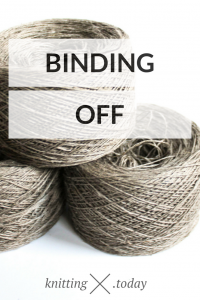Knitting Bind Off Methods
How are knitting projects finished? Here’s some inspiration to great endings for your knitting – this post is all about knitting bind off methods.
Knitting Bind Off Methods
Techniques for binding off are as numerous as techniques for casting on. There are bind-offs that produce firm edges, looser edges, stretchy edges, edges that look like the pattern stitch used, gathered edges, decorative edges, and bind-offs that join two edges together. It is wise to begin by learning a basic bind-off technique to use with your first few projects.
My Default Bind Off Method
My standard bind off method is to knit two stitches together, then slipping back the knitted stitch onto the left hand needle and repeat. It is also known as a chained bind off because the bind-off edge looks like a chain of stitches.
For a video, illustrations, and instructions for working a basic bind-off, click here.
Looser Bind-Offs
Some people find that their basic bind-off is too tight, making the bind-off edge too short and stiff, and possibly puckered. There are a number of tricks and alternate methods to achieve a looser bind off.
Relaxing a little and trying to work more loosely is the first thing to try to correct the problem of a too-tight bind off. The second possibility would be using a larger needle to bind-off.
You may also like to try one of the following techniques to achieve a looser bind-off.
Suspended Bind-Off
The Suspended Bind-Off is a variation on the Basic Bind-Off and can help ensure that the bind-off is not too tight. It is worked as follows.
When lifting the second stitch on the right needle over the first stitch, do not drop it from the tip of the left needle. This kind of suspends the stitch and ensures that it will not be drawn too tightly around the base of the first stitch. Bring the tip of the right needle in front of this suspended stitch and work the next stitch dropping both the stitch and the suspended stitch from the left needle.
Ribbed Bind-Off
The Ribbed Bind-Off is a variant of the basic bind-off using alternating knit and purl stitches instead of the basic k2tog. Just alternate between k2tog, p2tog (or k2tog twice, p2tog twice) like in the basic bind-off method. This creates a ribbed edge suitable for sock cuffs, for instance.
Sewn Bind-Off
Methods for binding off that use a yarn needle, instead of a second knitting needle, to carefully weave a long tail of yarn through the stitches of the last round are known as “sewn bind-offs”. The most basic sewn bind off can create a looser bind off edge and has the added benefit of producing an edge that mirrors the edge created by a long-tail cast-on.

What’s Your Favorite?
What’s your favorite knitting cast on method and why? Let me know by leaving a comment!


I don’t know what it’s called, but I knit a stitch then knit the next stitch and pass the first stitch over the second stitch and then knit the next stitch on the left needle and slip the stitch on the right needle over the new stitch and so on… It produces a nice evening edge, but I find it isn’t very stretchy. I lkie to make socks, but haven’t;to done to up due to not knowing a stretchy bind off.
Mine is similar (and I don’t know what it’s called) except, knit first stitch, knit second stitch, knit those 2 together, knit the next stitch, knit those together, etc.
It’s very stretchy, and sometimes looks messy on a garment that’s not being worn, because it is wider (especially on something that is ribbed, like a hat or socks), but it makes for a very non-binding cast off, if you know what I mean.
Pingback: Improving Your Knitting Skills in 30 Days - knitting.today
I agree…it’s good to know several ways of doing all things knitting. The situation calls for the method.
My favorite is the same as yours but each has its own usefulness. Sometimes I want a tight bind off edge to help with the structure of a shoulder seam and sometimes I need a soft, stretchy bottom on a sweater. It’s good to know several methods.
That’s so true! I rarely knit other things than shawls so usually tight bind off methods are not what I need, but it’s definitely good to know several methods.
Pingback: 365 Days of Shawl Knitting - knitting.today